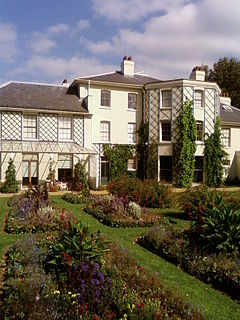Down House
| Down House | |
|---|---|
 |
|
| General information | |
| Address | Down House, Luxted Road, Downe, Orpington, BR6 7JT |
| Coordinates | 51°19′53″N 0°3′12″E / 51.33139°N 0.05333°ECoordinates: 51°19′53″N 0°3′12″E / 51.33139°N 0.05333°E |
| Owner | English Heritage |
| Website | |
| www |
|
Down House is the former home of the English naturalist Charles Darwin and his family. It was in this house and garden that Darwin worked on his theories of evolution by natural selection which he had conceived in London before moving to Down.
The house stands in Luxted Road 0.25 miles (0.40 km) south of Downe, a village 14.25 miles (22.93 km) south east of London's Charing Cross, which was still known as Down when he moved there in 1842. In Darwin's day, Downe was a parish in Kent: it subsequently came under Bromley Rural District, and since 1965 has lain within the London Borough of Bromley.
The house, garden and grounds are in the guardianship of English Heritage, have been restored and are open to the public.
In 1651 Thomas Manning sold a parcel of land including most of the current property to John Know the elder, from a Kentish yeoman family, for £345 (equivalent to £43,983 in present-day terms). It has been debated whether this price is likely to have included a house, but, if not, it was Know who built the first farmhouse on the property: some surviving flint walls may date from this period. In 1653 John Know gave the house to his son Roger, probably as a wedding present; and in 1743 the marriage of Mary Know passed the property to the family of Bartholomew of West Peckham in the Weald. In 1751 Leonard Bartholomew sold the uninhabited house on to Charles Hayes of Hatton Garden.
The property was acquired by the businessman and landowner George Butler in 1778, and it is thought that he rebuilt and enlarged the house: in 1781 he paid the highest window tax in the village. Around this time it was apparently called the Great House. After Butler died in 1783 the property changed hands several times, then in 1819 it went to Lieut.-Col. John Johnson, C.B., colonel of engineers in the Hon. East India Company, Bombay establishment. In 1837 Johnson migrated to "Lake Erie near Dunville in Upper Canada", and passed what was now called Down House on to the incumbent parson of the parish, the Rev. James Drummond. The house was re-roofed and brought into good order under the supervision of Edward Cresy, an architect who lived nearby. Around 1840 Drummond left the property vacant and put it up for auction, but it was unsold and lay empty for two years.
...
Wikipedia
